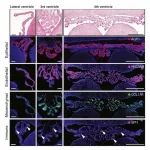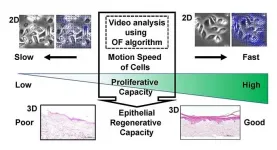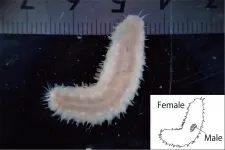(Press-News.org) Once viewed merely as a producer of the cerebrospinal fluid (CSF) bathing the brain and spinal cord, the choroid plexus is now known to be a key player in brain development and immunity. These fronds of brain tissue, located in the CSF-filled brain cavities known as ventricles, secrete instructive cues into the CSF to regulate brain development. They also function as an important barrier between the brain and the rest of the body.
Maria Lehtinen, PhD, of Boston Children's Hospital has done much of the pioneering work in understanding this once-obscure tissue. In new work published in Cell, Lehtinen, Neil Dani, PhD, and other colleagues at Boston Children's and the Broad Institute created a cellular and spatial "atlas" of the choroid plexus during different life stages (early development, adulthood, old age).
The map provides a benchmark to accelerate future studies investigating the lifelong regulation of this diminutive but influential brain structure.
"To fully understand the choroid plexus and its functions, we needed to identify its constituent cell types and their molecular composition," says Dani, who was co-first author on the paper with Rebecca Herbst, a PhD student at the Broad Institute. "Such insights had been missing in the community."
Extracting choroid plexus tissue
Isolating choroid plexus tissue from embryonic, adult, and aged mice was a job in itself. It required special micro-dissection approaches since these tissues lie deep within the brain's ventricles.
"Figuring out how to dissect out intact third-ventricle choroid plexus was particularly challenging," says Dani.
With tissue from each of the animals' three ventricles in hand, the researchers performed RNA sequencing of more than 98,000 cells and cell nuclei to compare their gene expression profiles (what genes were turned on or off). This enabled them to catalog different cell types and subtypes in choroid plexus from each ventricle, across different ages -- the first time this has ever been done.
"We had previously done bulk RNA sequencing of choroid plexus tissue, but that was like putting everything in a blender," says Lehtinen, who was co-senior author on the paper with Naomi Habib, PhD and Aviv Regev, PhD at the Broad Institute. "We didn't know which cells were secreting what. Sequencing cell by cell gives us a blueprint of what cells are where over the course of the lifespan. Knowing the different types of cells, we can explore their roles and functions, how they are talking to each other, and how the tissue is built."
A choroid plexus inventory
The investigations revealed a complex "architecture" of choroid plexus tissue specific to each ventricle. Gene expression varied especially among epithelial and fibroblast cells in the developing brain.
"We think the differences might have to do with helping guide the development of nearby brain regions," says Lehtinen. "There are different 'cocktails' of factors secreted into different ventricles, in different patterns."
In addition to the core cell types, the researchers found several neuronal subtypes. "Typically, the choroid plexus is not thought to have too many neurons," says Lehtinen. "What they're doing in the choroid plexus is still up for discussion and experimentation."
The sequencing data also revealed differences in the cells' secretions and molecular makeup.
"We were intrigued by the expression of insulin in the epithelial cells of the developing third ventricle choroid plexus," says Dani. "Whether this is a viable and functional central source of insulin in the brain needs further investigation. We also found that some epithelial and mesenchymal cells expressed ACE2 receptors, which the SARS-CoV-2 virus uses to enter cells. This underscores the need to understand how the choroid plexus functions not just in health but in disease."
Defending the brain
The team found a great deal of immune activity in the choroid plexus, with several kinds of immune cells residing there, most commonly macrophages. Immune signaling activity varied with age, with more inflammatory signals picked up in samples from aged brains.
"We can now start to analyze how different populations of immune cells are activated and how they respond to injury," says Lehtinen. "This gives us a baseline and a set of molecular markers to start looking at."
Other findings revealed the arrangement of arteries, veins, and capillaries in the choroid plexus, and their organization in relation to adjacent brain regions.
"Some of these vessels expressed blood-brain barrier proteins, which was not described before" notes Dani. "Once we mapped them, we found them to be continuous with arteries from adjacent brain regions."
A therapeutic 'window'?
With this resource in hand, the scientific community now has much to explore. Lehtinen and Dani believe that once the choroid plexus is better understood, it could provide a target for neurologic drugs.
"Gene therapy directed toward the CSF and choroid plexus could be an exciting therapeutic approach," says Lehtinen. "It's not going to fix everything, but it could have a sizeable impact."
In other work, Lehtinen and colleagues recently showed that before birth, the choroid plexus can be a conduit for inflammation caused by maternal infection, paving the way for studies of neurodevelopmental conditions such as autism. Another study found that a protein in the choroid plexus helps reduce excess fluid levels in the brain, potentially providing a target for treating hydrocephalus.
INFORMATION:
The current work was initially funded by a Boston Children's Hospital-Broad Institute collaboration grant. Other supporters include the National Institutes of Health, the Pediatric Hydrocephalus Foundation, the Reagan Sloane Shanley Scholarship, and the New York Stem Cell Foundation (see the paper for a full list).
About Boston Children's Hospital
Boston Children's Hospital is ranked the #1 children's hospital in the nation by U.S. News & World Report and is the primary pediatric teaching affiliate of Harvard Medical School. Home to the world's largest research enterprise based at a pediatric medical center, its discoveries have benefited both children and adults since 1869. Today, 3,000 researchers and scientific staff, including 9 members of the National Academy of Sciences, 23 members of the National Academy of Medicine and 12 Howard Hughes Medical Investigators comprise Boston Children's research community. Founded as a 20-bed hospital for children, Boston Children's is now a 415-bed comprehensive center for pediatric and adolescent health care. For more, visit our Answers blog and follow us on social media @BostonChildrens, @BCH_Innovations, Facebook and YouTube.
The friendship paradox is the observation that the degrees of the neighbors of a node within any network will, on average, be greater than the degree of the node itself. In other words: your friends probably have more friends than you do.
While the standard framing of the friendship paradox is essentially about averages, significant variations occur too.
In the Journal of Complex Networks, Santa Fe Institute and University of Michigan researchers George Cantwell, Alec Kirkley, and Mark Newman address this by developing the mathematical theory ...
Carried like stowaways in the guts of international travelers, new and potentially deadly strains of antimicrobial resistant superbugs may be coming to a community near you, suggests new research from Washington University School of Medicine in St. Louis.
"Even before the COVID-19 pandemic, we knew that international travel was contributing to the rapid global increase and spread of antimicrobial resistance," said Alaric D'Souza, an MD/PhD student at Washington University and a co-first author of the study to be published June 6 in Genome Medicine. "But what's new here is that we've found numerous completely novel genes associated with antimicrobial ...
Climate experts warn that, without urgent action, climate change will continue to cause an increase in the intensity of extreme rainfall that can lead to severe flooding.
An international research team have concluded that increases in extreme rainfall and associated flooding are projected to continue as global temperatures continue to rise. Efforts to limit warming to +1.5C will help limit changes in extreme rainfall, though some societal adaptations will still be required.
Sharing their findings in a new ScienceBrief Review, published today (7 June), scientists ...
Niigata, Japan - A comprehensive investigation on cells and colony motion offers new insight into the proliferative and epithelial regenerative capacities of human primary oral keratinocyte cultures with implications for quality control of engineered cells used in regenerative medicine. Dr. Kenji Izumi and his colleagues, Dr. Emi Hoshikawa and Dr. Taisuke Sato, modified the optical flow (OF) protocol originally presented in their 2019 paper to add the capacity to determine the threshold of the cells/colony motion speed required to differentiate substandard oral keratinocyte populations before manufacturing a tissue-engineered oral mucosa tissue construct. ...
The world is one step closer to ultimately secure conference calls, thanks to a collaboration between Quantum Communications Hub researchers and their German colleagues, enabling a quantum-secure conversation to take place between four parties simultaneously.
The demonstration, led by Hub researchers based at Heriot-Watt University and published in Science Advances, is a timely advance, given the global reliance on remote collaborative working, including conference calls, since the start of the C19 pandemic.
There have been reports of significant escalation of cyber-attacks on popular teleconferencing platforms in the last year. This advance in quantum secured communications could lead to conference calls with inherent unhackable security measures, underpinned by the principles of ...
In the Kumano Sea, off the southeast coast of Japan, an evolutionary mystery lay in wait. Researchers collected samples from the muddy sea floor, including hermit crabs, mollusks and discarded shells. Here, in and on these shells, they found scale worms living mostly in pairs with a striking difference compared to the almost 900 already known species of scale worms: one was a quarter the size of its mate.
The discovery was published on March 29 as the cover of the Journal of Zoological Systematics and Evolutionary Research.
"The species is characterized by males being dwarf, with their minute bodies always riding on the dorsal side of females," said paper author Naoto Jimi, postdoctoral researcher at the National Institute of Polar Research, Research ...
(Geneva, 5 June 2021) Mass screening of school age children has led to significantly higher numbers of coeliac disease cases being diagnosed, according to a new study presented today at the 6th World Congress of Paediatric Gastroenterology, Hepatology and Nutrition.
Researchers in Italy found double the number of cases of the autoimmune disease - where the body produces antibodies to gluten, a protein found in wheat, barley, and rye - in school children compared to a similar study by the same group 25 years ago.
A new screening programme of 7,760 children aged from five ...
(Geneva, 5 June 2021) Procedures to prevent the direct transmission of hepatitis B virus (HBV) from mother to child, particularly during and after pregnancy, have significant fragmentation and gaps, a new survey presented at the 6th World Congress of Paediatric Gastroenterology, Hepatology and Nutrition has shown.
The results, based on 76 delivery hospitals from ten major European countries*, identified significant variances in maternal HBV screening frequency during pregnancy: 53% in the first trimester, 1% in the second trimester and 46% in the third trimester. Alarmingly, only 38% of those women who tested positive with high HBV-DNA levels were treated ...
MADISON, Wis. -- If you're wearing gold jewelry right now, there's a good chance it came from an illegal mining operation in the tropics and surfaced only after some rainforest was sacrificed, according to a team of University of Wisconsin-Madison researchers and alumni who studied regulatory efforts to curb some of these environmentally damaging activities in the Amazon.
The researchers, including UW-Madison geography Professor Lisa Naughton, investigated mining-related deforestation in a biodiverse and ecologically sensitive area of the Peruvian Amazon to see whether formalizing and legalizing these mining operations might curb some of their negative effects.
Their study, published June 2 in the journal Environmental Research Letters, was co-authored by a group including UW-Madison ...
In a large, international retrospective study, men at high risk for death from prostate cancer had a significant reduction in all-cause mortality if treated with radiation shortly after surgery.
Prostate cancer is one of the most common forms of cancer among men, and about 1-in-8 of them will be diagnosed with it during their lifetime. While most men are cured with available treatment, there remains a group at high risk for death. In the United States in 2020, 33,330 men died from the disease, making prostate cancer the second leading cause of cancer death for men in this country. Therefore, among those at highest risk of recurrence, metastasis, and death from prostate cancer, understanding what steps can be taken to lower these risks could save and extend lives.
Early ...



